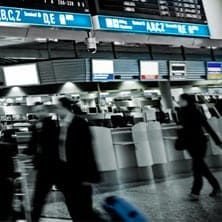
Our Terminal Passenger Behaviour Modelling Tool, as explained on our last blog has given us a fascinating insight into airports. We often call them little cities, and this simulation has shown us just how similar they are. We can now gain far more detail into knowing where passengers are and what they are doing, at any given time. This helps us, and our clients, when considering capacity and demand forecasting.
It has also assisted us in other ways, particularly when looking at cultural differences, across the UK and airports worldwide. When we were asked to undertake an Airport Capacity Assessment to augment capacity at Hyderabad International Airport (also known as Rajiv Gandhi International Airport), utilising the existing Terminal footprint, we could use this cultural knowledge to understand how people use the airport.
In Asia, in particular, far more family members go to wave off passengers when departing. This can be a problem for airports, creating bottlenecks and problems with security, so we can use this knowledge of where people are in the terminal at any given moment to work with other stakeholders to ensure that the airport works in a way that filters off these relatives efficiently.
We can also apply this when assessing Heathrow terminals, by applying the same cultural implications to airlines and flights that serve Asia. So we know, for example, exactly when coffee shops in Departures Landside are going to fill up with crying relatives saying goodbye! This also goes for other flights and schedules, as we can predict the build up in Costa Coffee at Arrivals for taxi drivers waiting for their fares…
It is this knowledge that can also inform airports about how and where to place retail concessions, store baggage trollies, and transport passengers using Premium or PRM buggies in the most efficient way. For retail and food in particular, this is a great help to airports, as it is one of only a few ways they earn money. The most effective placement of stores can raise footfall, increase sales, and therefore boost the revenue paid to the airport owner.
To find out more about our Terminal Passenger Behaviour Modelling Tool, and how it can increase efficiency and capacity in your airport, contact us today.

